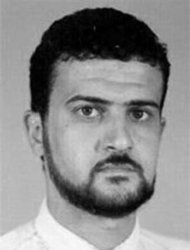 U.S. forces launched raids in Libya and Somalia on Saturday, two
weeks after the deadly Islamist attack on a Nairobi shopping mall,
capturing a top al Qaeda figure wanted for the 1998 U.S. embassy
bombings in Kenya and Tanzania, U.S. officials said.
U.S. forces launched raids in Libya and Somalia on Saturday, two
weeks after the deadly Islamist attack on a Nairobi shopping mall,
capturing a top al Qaeda figure wanted for the 1998 U.S. embassy
bombings in Kenya and Tanzania, U.S. officials said.
Senior al Qaeda figure Anas al Liby was seized in the raid in Libya, but no militant was captured in the raid on the Somali town of Barawe, the officials said, speaking on condition of anonymity.
Liby, believed to be 49, has been under U.S. indictment for his alleged role in the East Africa embassy bombings that killed 224 people.
The U.S. government has also been offering a $5 million reward for information leading to his capture, under the State Department's Rewards for Justice program.
CNN reported in September last year that Liby had been seen in the Libyan capital, Tripoli. It quoted Western intelligence sources as saying there was concern that he may have been tasked with establishing an al Qaeda network in Libya.
That CNN report quoted counterterrorism analysts as saying that Liby may not have been apprehended then because of the delicate security situation in much of the country, where former jihadists hold sway. It quoted one intelligence source as saying that Liby appeared to have arrived in Libya in the spring of 2011, during the country's civil war.
The Pentagon confirmed U.S. military personnel had been involved in an operation against what it called "a known al Shabaab terrorist," in Somalia, but gave no more details.
One U.S. official, speaking to Reuters on condition of anonymity, said the al Shabaab leader targeted in the operation was neither captured nor killed.
U.S. officials did not identify the target. They said U.S. forces, trying to avoid civilian casualties, disengaged after inflicting some al Shabaab casualties. They said no U.S. personnel were wounded or killed in the operation, which one U.S. source said was carried out by a Navy SEAL team.
SOMALIA FIREFIGHT
The New York Times quoted witnesses as saying that the firefight lasted more than an hour, with helicopters called in for air support.
The Times report quoted a spokesman for al Shabaab as saying that one of its fighters had been killed in an exchange of gunfire but that the group had beaten back the assault.
The paper quoted said a senior Somali government official as saying that the government "was pre-informed about the attack."
It quoted an unnammed unnamed U.S. security official as saying that the Barawe raid was planned a week and a half ago.
"It was prompted by the Westgate attack," he added, referring to a militant assault on a Nairobi shopping mall two weeks ago in which at least 67 people were killed.
Earlier, al Shabaab militants said British and Turkish special forces had raided Barawe overnight, killing a rebel fighter, but that a British officer had also been killed and others wounded.
Britain's Defence Ministry said it was not aware of any such British involvement. A Turkish Foreign Ministry official also denied any Turkish part in such an action.
A Somali intelligence official said the target of the raid at Barawe was a Chechen commander, who had been wounded and his guard killed. Police said a total of seven people were killed.
Sheikh Abdiasis Abu Musab, spokesman for al Shabaab's military operations, told Reuters that foreign forces had landed on the beach at Barawe, about 180 km (110 miles) south of Mogadishu, and launched an assault that drew gunfire from rebel fighters in one of the militia's coastal bases.
Residents said fighting erupted at about 3 a.m. (midnight GMT). "We were awoken by heavy gunfire last night, we thought an al Shabaab base at the beach was captured," Sumira Nur, a mother of four, told Reuters from Barawe on Saturday.
"We also heard sounds of shells, but we do not know where they landed."
In 2009, helicopter-borne U.S. special forces killed senior al Qaeda militant Saleh Ali Saleh Nabhan in a raid in southern Somalia. Nabhan was suspected of building the bomb that killed 15 people at an Israeli-owned hotel on the Kenyan coast in 2002.
The United States has used drones to kill fighters in Somalia in the past. In January 2012, members of the elite U.S. Navy SEALs rescued two aid workers after killing their nine kidnappers.
Shabaab leader Ahmed Godane, also known as Mukhtar Abu al-Zubayr, has described the Nairobi mall attack as retaliation for Kenya's incursion in October 2011 into southern Somalia to crush the insurgents. It has raised concern in the West over the operations of Shabaab in the region.
No comments:
Post a Comment